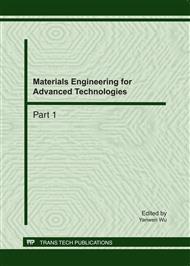p.448
p.453
p.459
p.466
p.472
p.478
p.484
p.490
p.496
450°C-Based Pyrolysis- GC/MS Analysis of Utilization of Benzene/Ethanol-Extracted Residue from Oil-Tea Cake
Abstract:
The extractives of oil-tea cake are considered to have bioactive components, but the extracted residues of oil-tea cake are still not utilized. The analytical result by 450°C-based Pyrolysis-GC/MS showed that 42 peaks were obtained from the 450°C pyrolyzate of benzene/ethanol-extracted residues of oil-tea cake, and 41 compounds representing 97.53% of the total areas were identified. The analytical result revealed that the main components of benzene/ethanol-extracted residues of oil-tea cake by 450°C-based pyrolysis- GC/MS were as: Ethanone, 1-(2-Hydroxy-5-Methylphenyl)- (19.16%), Phenol, 2-Methoxy-6-(2-Propenyl)- (15.24%), Mequinol (14.37%), 2-Cyclohexen-1-One, 4,4,6-Trimethyl- (6.51%), 1,2-Cyclobutanedicarboxylic Acid, Trans- (5.68%), 3-Tert-Butyl-4-Hydroxyanisole (4.92%), Phenol, 2-Methoxy-4-Methyl- (4.33%), Phenol, 4-Ethyl-2-Methoxy- (3.62%), Vanillin (3.59%), Phenol, 2,6-Dimethoxy-4- (2-Propenyl)- (3.17%), N,N-Dimethyl-2-Cyclohexyloxyethylamine (2.94%), 1,3-Cyclopentanedione, 2-Methyl- (2.85%), Eugenol (2.56%), etc. The results of function analyses showed that the benzene/ethanol-extracted residues of oil-tea cake contain abundant components of rare natural medicinal materials, and materials of high-grade spice, cosmetic and food industry.
Info:
Periodical:
Pages:
472-477
Citation:
Online since:
June 2011
Authors:
Price:
Сopyright:
© 2011 Trans Tech Publications Ltd. All Rights Reserved
Share:
Citation:


